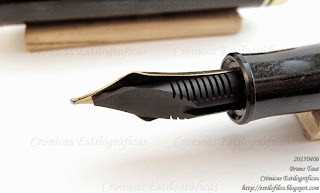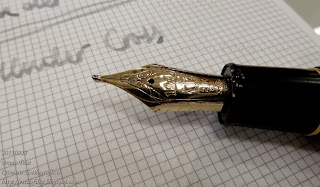Japan is not different, and a number of copies of all those models have appeared on these Chronicles: The Eiko, a Platinum 10 Years, modern torpedo models… to name just a few.
In 1929, Pilot released a desk pen in bright yellow color. The base, Masa Sunami shows in the book Fountain Pens of Japan (A. LAMBROU and M. SUNAMI. ISBN 978-0-9571723-0-2), is equally yellow and includes a calendar. The pen itself is impressive enough on its own merits—bright yellow with black section and tail--truly inspired in the well known Duofold Mandarin Yellow by Parker.

The barrel is engraved: "PILOT" / US PAT (Namiki N logo) * 1600293 / PILOT PEN MFG CO LTD. The asterisk (*) means that there might have been some character in there, but it is now unreadable. The patent deserves some reflections by itself.
This Pilot, however, is a lever filler and implements a relatively small nib—a size 3 made of 14 K gold with a very appropriate, dare I say, posting point.
These are its dimensions:
- Length (open): 185 mm
- Diameter: 9 mm
- Weight (dry): 13.8 g
This particular unit was made in 1929 according to the imprint on the nib.
My thanks to Mr. Mochizuki and Mr. Sunami.
Romillo Essential Black – Parker Quink Blue
Bruno Taut
Shinjuku, April 20th, 2015
etiquetas: Pilot, Parker, Japón
Bruno Taut
Shinjuku, April 20th, 2015
etiquetas: Pilot, Parker, Japón
















































